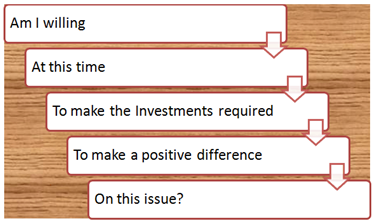
Triggers are similar to the popular song, “Sign, sign everywhere a sign” by Five Man Electric Band. They are present EVERYWHERE in our environment.
Goldsmith says, “A trigger is any stimulus that reshapes our thoughts and actions. In every waking hour we are being triggered by people, events, and circumstances that have the potential to change us.” (Goldsmith, intro xv)
So why does it seem so difficult to become the person you desire to be? To become the ideal you, instead of who you are now? Well, according to Marshall Goldsmith in his book Triggers, –environmental triggers block and prevent positive change along with individual lack of engagement in the changes desired.
In his book Triggers, Goldsmith provides a multi-step practical approach to implementing positive changes that will “stick”, for life.
He begins with a discussion about “Belief triggers that stop behavioral changes in its tracks” (Goldsmith, 12)
- If I understand, I will do. You can’t just KNOW what you’d like to do, you must actually DO it.
- I have will power and won’t give in to temptation. We overestimate willpower and underestimate environmental triggers that challenge our willpower.
- Today is a special day. I can cheat and eat junk food today because it’s my birthday, my friend’s birthday, the Super Bowl, Halloween etc…
- At least I’m better than… Exactly what it says. When we use another as an example of someone we view as less than.
- I shouldn’t need help and structure. Help and structure is too simple and unnecessary. I can certainly get by without that checklist as a reminder…
- I won’t get tired and my enthusiasm will not fail. Understand your body and know that you do get tired and your enthusiasm will fade and willpower fail.
- I have all the time in the world. It’s typical to underestimate the time it takes to complete a task and also to feel you have an endless amount of time to do so.
- I won’t get distracted and nothing unexpected will occur. We’re not good at contingency planning.
- An epiphany will suddenly change my life. Thinking one day you’ll wake up and change will be easy because you had an epiphany or suddenly got more willpower.
- My change will be permanent and I will never have to worry again. I quit smoking so surely one cigarette won’t make me start smoking again.
- My elimination of old problems will not bring on new problems. Just solving an old problem doesn’t mean new problems won’t occur.
- My efforts will be fairly rewarded. Life isn’t fair so don’t always assume you’ll be rewarded according to your efforts.
- No one is paying attention to me. I can do whatever I want and no-one will notice because no one is paying attention to me.
- If I change, I am ‘inauthentic’. If I change it goes against my “true self” which is a misconception because individuals don’t have fixed and constant selves, -we evolve through the years.
- I have the wisdom to assess my own behavior. The misconception that you are self reflective enough to no longer need objectivity or support from others. (14-24)
Being aware of these behavioral triggers is not enough to force positive change. Besides understanding how belief triggers block progress, one must establish clear goals, set actions to accomplish these goals and regularly measure progress using active questions that engage you in focusing on your control over your behaviors, attitudes, and actions.
Goldsmith relates to a study where he compared progress to those who rated their responses to active questions vs. passive questions. Passive questions are those that may start off like this, “How happy were you today?” vs. active question, “Did you do your best to be happy today.” See the difference? Responses to passive questions revealed individuals blaming their external environment for their lack of progress or results vs. active questions which focused on individual’s owning their progress or results. He calls active questions one his fourth magic moves. (101-110)
Along with putting active questions into action, individuals must practice AIWATT (Am I willing, at this time), “The delaying mechanism we should be deploying in the interval between trigger and behavior – after a trigger creates an impulse and before behavior we may regret.” (152-158)

In order to become the person we desire to be we need to remember, “We do not get better without structure. But it has to be the right structure” (169, 175) so put Goldsmith’s practices into action and you’ll avoid, “Triggers -sparking positive change and making it last.” (book title)
Goldsmith, Marshall. Triggers, Sparking Positive Change and Making it Last. London: Profile Books LTD, 2015. Print